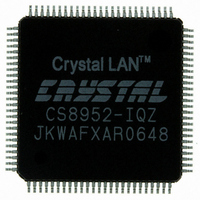CS8952-IQZ Cirrus Logic Inc, CS8952-IQZ Datasheet - Page 23

CS8952-IQZ
Manufacturer Part Number
CS8952-IQZ
Description
IC TXRX 100/10 PHY 100TQFP
Manufacturer
Cirrus Logic Inc
Type
Transceiverr
Datasheet
1.CS8952-IQZ.pdf
(81 pages)
Specifications of CS8952-IQZ
Package / Case
100-TQFP, 100-VQFP
Protocol
MII
Voltage - Supply
4.75 V ~ 5.25 V
Mounting Type
Surface Mount
Minimum Operating Temperature
0 C
Mounting Style
SMD/SMT
Product
Ethernet Transceivers
Number Of Transceivers
1
Standard Supported
100BASE-FX or 100BASE-TX or 10BASE-T
Data Rate
10 Mbps or 100 Mbps
Supply Voltage (max)
6 V
Supply Voltage (min)
- 0.3 V
Supply Current (max)
+/- 10 mA
Maximum Operating Temperature
+ 70 C
Lead Free Status / RoHS Status
Lead free / RoHS Compliant
Number Of Drivers/receivers
-
Lead Free Status / Rohs Status
Lead free / RoHS Compliant
Other names
598-1208
Available stocks
Company
Part Number
Manufacturer
Quantity
Price
Company:
Part Number:
CS8952-IQZ
Manufacturer:
CIRRUS
Quantity:
560
Company:
Part Number:
CS8952-IQZ
Manufacturer:
CIRRUS
Quantity:
70
Part Number:
CS8952-IQZ
Manufacturer:
CRYSTAL
Quantity:
20 000
Company:
Part Number:
CS8952-IQZR
Manufacturer:
Cirrus Logic Inc
Quantity:
10 000
RX_CLK, RX_DV, COL, and CRS) onto a shared,
external repeater system bus.
3.1.3
The digital interface used in this mode is the same
as that used in the 100BASE-X MII mode except
that TX_CLK and RX_CLK are nominally
2.5 MHz.
The CS8952 includes a full-featured 10BASE-T in-
terface, as described in the following sections.
3.1.3.1
The 10BASE-T function supports full and half du-
plex operation as determined by pins AN[1:0]
and/or the corresponding MII register bits. (See Ta-
ble 5).
3.1.3.2
If half duplex operation is selected, the CS8952 de-
tects a 10BASE-T collision whenever the receiver
and transmitter are active simultaneously. When a
collision is present, the collision is reported on pin
COL. Collision detection is undefined for full-du-
plex operation.
3.1.3.3
The jabber timer monitors the transmitter and dis-
ables the transmission if the transmitter is active for
greater than approximately 105 ms. The transmitter
stays disabled until approximately 406 ms after the
internal transmit request is no longer enabled.
3.1.3.4
To prevent disruption of network operation due to a
faulty link segment, the CS8952 continually moni-
tors the 10BASE-T receive pair (RXD+ and RXD-)
for packets and link pulses. After each packet or link
pulse is received, an internal Link-Loss timer is
started. As long as a packet or link pulse is received
before the Link-Loss timer finishes (between 50 and
100 ms), the CS8952 maintains normal operation. If
no receive activity is detected, the CS8952 disables
CrystalLAN™ 100BASE-X and 10BASE-T Transceiver
DS206F1
10BASE-T MII Application
Full and Half Duplex operation
Collision Detection
Jabber
Link Pulses
packet transmission to prevent “blind” transmis-
sions onto the network (link pulses are still sent
while packet transmission is disabled). To reactivate
transmission, the receiver must detect a single pack-
et (the packet itself is ignored), or two normal link
pulses separated by more than 6 ms and no more
than 50 ms.
The CS8952 automatically checks the polarity of
the receive half of the twisted pair cable. To detect
a reversed pair, the receiver examines received link
pulses and the End-of-Frame (EOF) sequence of
incoming packets. If it detects at least one reversed
link pulse and at least four frames in a row with
negative polarity after the EOF, the receive pair is
considered reversed. If the polarity is reversed and
bit 1 of the 10BASE-T Configuration Register (ad-
dress 1Ch), is set, the CS8952 automatically cor-
rects a reversal.
In the absence of transmit packets, the transmitter
generates
Section 14.2.1.1 of the Ethernet standard. Trans-
mitted link pulses are positive pulses, one bit time
wide, typically generated at a rate of one every
16 ms. The 16 ms timer also starts whenever the
transmitter completes an End-of-Frame (EOF) se-
quence. Thus, a link pulse will be generated 16 ms
after an EOF unless there is another transmitted
packet.
3.1.3.5
The 10BASE-T squelch circuit determines when
valid data is present on the RXD+/RXD- pair. In-
coming signals passing through the receive filter
are tested by the squelch circuit. Any signal with
amplitude less than the squelch threshold (either
positive or negative, depending on polarity) is re-
jected.
3.1.3.6
When Loopback is selected, the TXD[3:0] pins are
looped back into the RXD[3:0] pins through the
Receiver Squelch
10BASE-T Loopback
link
pulses
in
accordance
CS8952
with
23


















